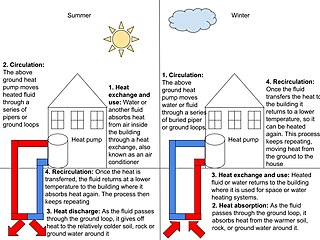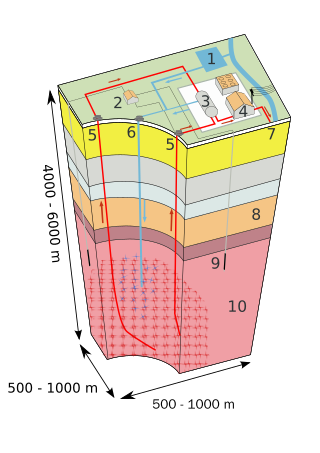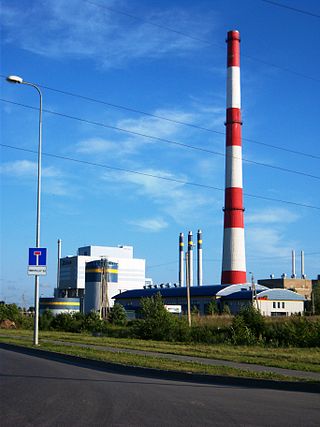Related Research Articles

Geothermal energy is thermal energy extracted from the Earth's crust. It combines energy from the formation of the planet and from radioactive decay. Geothermal energy has been exploited as a source of heat and/or electric power for millennia.

Geothermal heating is the direct use of geothermal energy for some heating applications. Humans have taken advantage of geothermal heat this way since the Paleolithic era. Approximately seventy countries made direct use of a total of 270 PJ of geothermal heating in 2004. As of 2007, 28 GW of geothermal heating capacity is installed around the world, satisfying 0.07% of global primary energy consumption. Thermal efficiency is high since no energy conversion is needed, but capacity factors tend to be low since the heat is mostly needed in the winter.

A ground source heat pump is a heating/cooling system for buildings that use a type of heat pump to transfer heat to or from the ground, taking advantage of the relative constancy of temperatures of the earth through the seasons. Ground-source heat pumps (GSHPs) – or geothermal heat pumps (GHP), as they are commonly termed in North America – are among the most energy-efficient technologies for providing HVAC and water heating, using far less energy than can be achieved by burning a fuel in a boiler/furnace or by use of resistive electric heaters.

The potential for exploiting geothermal energy in the United Kingdom on a commercial basis was initially examined by the Department of Energy in the wake of the 1973 oil crisis. Several regions of the country were identified, but interest in developing them was lost as petroleum prices fell. Although the UK is not actively volcanic, a large heat resource is potentially available via shallow geothermal ground source heat pumps, shallow aquifers and deep saline aquifers in the mesozoic basins of the UK. Geothermal energy is plentiful beneath the UK, although it is not readily accessible currently except in specific locations.

Geothermal power in Australia was at one time hoped to provide cost effect, renewable power for Australia. There are locations that have been shown to contain hot granites at depth which hold good potential for development of geothermal energy. Exploratory geothermal wells have been drilled to test for the presence of high temperature geothermal reservoir rocks and such hot granites were detected. However, all these projects have since been abandoned. A small geothermal plant in Queensland experienced problems during commissioning and as at May 2022, remains idle.

Geothermal energy in the United States was first used for electric power production in 1960. The Geysers in Sonoma and Lake counties, California was developed into what is now the largest geothermal steam electrical plant in the world, at 1,517 megawatts. Other geothermal steam fields are known in the western United States and Alaska. Geothermally generated electric power can be dispatchable to follow the demands of changing loads. Environmental impact of this energy source includes hydrogen sulfide emissions, corrosive or saline chemicals discharged in waste water, possible seismic effects from water injection into rock formations, waste heat and noise.

An enhanced geothermal system (EGS) generates geothermal electricity without natural convective hydrothermal resources. Traditionally, geothermal power systems operated only where naturally occurring heat, water, and rock permeability are sufficient to allow energy extraction. However, most geothermal energy within reach of conventional techniques is in dry and impermeable rock. EGS technologies expand the availability of geothermal resources through stimulation methods, such as 'hydraulic stimulation'.

Geothermal power is electrical power generated from geothermal energy. Technologies in use include dry steam power stations, flash steam power stations and binary cycle power stations. Geothermal electricity generation is currently used in 26 countries, while geothermal heating is in use in 70 countries.

Geothermal energy is a significant part of renewable energy in Turkey: it is used for geothermal heating and generates 3% of the nation's electricity. Turkey is the world's second largest user of geothermal heating, after China. Many greenhouses, spas and homes are heated by underground water; and many more buildings could be heated in this way.

A direct exchange (DX) geothermal heat pump is a type of ground source heat pump in which refrigerant circulates through copper tubing placed in the ground unlike other ground source heat pumps where refrigerant is restricted to the heat pump itself with a secondary loop in the ground filled with a mixture of water and anti-freeze.

The Klaipėda Geothermal Demonstration Plant is a geothermal heating plant in Klaipėda, Lithuania, constructed during the late 1990s and early 2000s. It was the first geothermal heating plant in the Baltic Sea region. Its purpose was to reduce carbon dioxide, sulfur dioxide, nitrogen oxide, and particulate emissions in the area, as well as to reduce Lithuania's dependence on foreign energy sources. The plant supplies district heating to the city. Construction was financed by a loan from the World Bank (US$5.9 million) and a grant from the Global Environment Facility (US$6.9 million). The Danish state company Dansk Olie og Naturgas provided technical support, and Enterprise Geoterma served as the implementing agency. The total cost of the plant was US$19.5 million. Since 2017 it has been closed due to financial and technical issues.

Canada has substantial potential for geothermal energy development. To date, development has all been for heating applications. Canada has 103,523 direct use installations as of 2013. There is currently no electricity being generated from geothermal sources in Canada although substantial potential exists in the Canadian Cordillera. The most advanced project exists as a test geothermal-electrical site at the Mount Meager massif in British Columbia, where a 100 MegaWatt (MW) facility could be developed. Potential for enhanced geothermal energy systems (EGS) exists throughout Canada. There are six geothermal power and two direct use projects listed with the Canadian Geothermal Energy Association.
AltaRock Energy Inc. is a privately held corporation that focuses on the development of geothermal energy resources and enhanced geothermal systems (EGS). It is headquartered in Seattle, Washington and has a technology development office in Sausalito, California. AltaRock has filed patent applications and holds exclusive licenses for related intellectual property related to EGS. In 2008 it started its first project near The Geysers in California to demonstrate the ability of EGS to be a reliable, renewable and clean source for the production of electric power.
United Downs Deep Geothermal Power is the United Kingdom's first geothermal electricity project. It is situated near Redruth in Cornwall, England. It is owned and operated by Geothermal Engineering (GEL), a private UK company. The drilling site is on the United Downs industrial estate, chosen for its geology, existing grid connection, proximity to access roads and limited impact on local communities. Energy is extracted by cycling water through a naturally hot reservoir and using the heated water to drive a turbine to produce electricity and for direct heating. The company plans to begin delivering electricity and heat in 2024. A lithium resource was discovered in the well.
Blue Mountain Faulkner 1 Geothermal Power Plant is a geothermal power plant located in Humboldt County, Nevada, United States. It is owned and operated by Nevada Geothermal Power Inc. Produced electricity is sold to NV Energy through a 21-mile (34 km) 120-kV transmission line to the transmission grid connection at Mill City, Nevada.

The Puna Geothermal Venture (PGV) is a geothermal energy power plant on the island of Hawaii, the largest island in the state of Hawaii. The plant was shut down shortly after the start of the May 2018 lower Puna eruption, and resumed power generation in November 2020. The eruption had caused lava to flow over a PGV power substation, a warehouse and at least three geothermal wells that had been preventatively quenched and capped when lava fountains erupted nearby, eventually also cutting off road access.

Solar augmented geothermal energy (SAGE) is an advanced method of geothermal energy that creates a synthetic geothermal storage resource by heating a natural brine with solar energy and adding enough heat when the sun shines to generate power 24 hours a day. The earth is given enough energy in one hour to provide all electrical needs for a year. Available energy is not the issue, but energy storage is the problem and SAGE creates effective storage and electrical power delivery on demand. This technology is especially effective for geothermal wells that have demonstrated inconsistent heat or idle oil or gas fields that have demonstrated the proper geology and have an abundance of solar.

Closed-loop geothermal systems are a type of engineered geothermal energy system containing subsurface working fluid that is heated in a hot rock reservoir without direct contact with rock pores and fractures.: Instead, the subsurface working fluid stays inside a closed loop of deeply buried pipes that conduct Earth’s heat. Closed-loop geothermal systems are one of the prominent categories of next-generation geothermal systems in development today.
Fervo Energy is an energy resource company focused on harnessing heat through enhanced geothermal systems (EGS). It was co-founded in 2017 by Tim Latimer, a mechanical engineer who worked as a drilling engineer at BHP until 2015. His departure from the oil and gas sector was driven by a desire to apply techniques observed during the shale revolution to geothermal extraction.
References
- ↑ "First-of-its-kind geothermal pilot project underway in Alberta". Emissions Reduction Alberta. 2019-08-22. Retrieved 2020-11-27.
- ↑ "Eavor Technologies commences construction of geothermal demonstration facility". Think GeoEnergy - Geothermal Energy News. 6 August 2019. Retrieved 2020-11-27.
- ↑ "Eavor's green baseload power technology demonstrated and verified". www.geodrillinginternational.com. 2020-02-07. Retrieved 2020-11-27.
- ↑ "Yukon First Nation signs deal for new geothermal project | CBC News". CBC. Retrieved 2020-11-27.
- ↑ "Eavor, Enex to co-develop geothermal heat and power project in Germany". Renewablesnow.com. Retrieved 2020-11-27.
- ↑ "Eavor Announces a Commercial Eavor-Loop Project to be built in Geretsried, Germany – Eavor". May 2020. Retrieved 2021-09-26.
- ↑ Graham (2023-07-14). "Chubu Electric Power Co. Inc. Participating in World's First Commercial Eavor-Loop™". Eavor. Retrieved 2023-07-22.
- ↑ Cariaga, Carlo (8 December 2022). "Eavor and Deep Capital to build five geothermal projects". ThinkGeoEnergy. Retrieved 18 January 2023.
- ↑ Cariaga, Carlo (28 October 2022). "Eavor and Enex break ground on geothermal project in Geretsried, Germany". ThinkGeoEnergy. Retrieved 18 January 2023.